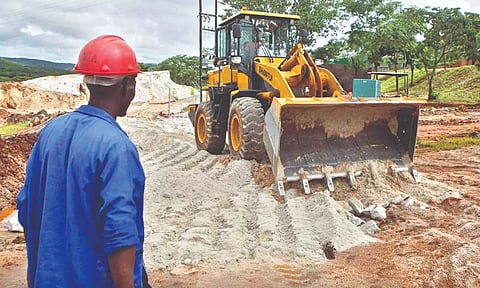

By Kate Hairsine
WINDHOEK: At a Chinese-run lithium mine in Namibia, local workers have complained for months about squalid living conditions and unsafe work practices. An August fact-finding mission by the Mineworkers Union of Namibia into the Uis mine — which is operated by Chinese mining company Xinfeng Investments — found that the mine’s local employees live in tiny, hot shacks made of corrugated zinc and without proper ventilation.
The union also faulted a lack of privacy in the sanitation blocks, where toilets and showers are lined up without partitions between them. By contrast, the mine’s Chinese workers have comfortable air-conditioned rooms and decent bathrooms. The union also criticized Xinfeng for failing to provide protective clothing and ensure adequate safety measures were in place for local workers. This is not the only controversy surrounding Xinfeng Investments. A new investigation into lithium mining in Africa by UK-based nonprofit Global Witness outlines accusations against the firm, ranging from acquiring the industrial mine in Uis through bribery to developing it using permits intended for artisanal miners.
Developing the mine with small-scale licenses meant the company paid “a staggeringly low amount for access” to the lithium deposit and allowed it to skirt some environmental regulations, the investigation says.
As well as in Namibia, the report also documents human rights abuses, corruption, displacement and unsafe working practices in lithium mines in the Democratic Republic of the Congo and Zimbabwe. “Going back decades, the mining sector in Africa has often involved corruption and communities not really getting a share of the profits,” said Global Witness senior investigator Colin Robertson, one of the report’s authors. “What we found in the lithium sector is that this trend is set to continue. … This is very concerning.”
Called the “white gold” of the renewable energy revolution, lithium is a key component of the rechargeable lithium-ion batteries that power everything from cellphones to electric cars. Such batteries are also vital for storing energy produced by clean energy like solar or wind if the world is to make the break from fossil fuels. Globally, the lithium supply is currently dominated by Australia, Chile and China, who together produced 90% of the light metal in 2022. But with about 5% of the world’s lithium ore reserves, Africa still holds enormous potential, most of which is untapped. Currently only Zimbabwe and Namibia export lithium ore, while projects in nations such as Congo, Mali, Ghana, Nigeria, Rwanda and Ethiopia are under exploration or development.
With demand for the critical mineral expected to boom — it could grow fortyfold by 2040, according to projections from the International Energy Agency — major economies and international companies are racing to secure access to lithium on the continent. Many African nations are embracing the lithium rush.
“Lithium is the mineral of the present and the future,” Zimbabwean President Emmerson Mnangagwa said recently. Zimbabwe, which has Africa’s largest lithium reserves and is ranked sixth globally for lithium exports, earned $209 million (193 million euros) from the mineral in the first nine months of 2023. That’s nearly triple last year’s earnings. The southern African country, along with Namibia and Tanzania, has banned the export of raw, or unprocessed lithium, as it seeks to get added value from the lightweight metal.